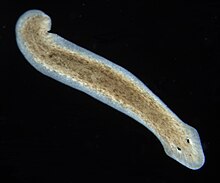| Dugesia subtentaculata | |
|---|---|
 | |
| Asexual specimen of Dugesia subtentaculata | |
| Scientific classification | |
| Domain: | Eukaryota |
| Kingdom: | Animalia |
| Phylum: | Platyhelminthes |
| Order: | Tricladida |
| Family: | Dugesiidae |
| Genus: | Dugesia |
| Species: | D. subtentaculata |
| Binomial name | |
| Dugesia subtentaculata (Draparnaud, 1801) | |
| Synonyms | |
Dugesia subtentaculata is a species of planarian that inhabits the freshwater of Southern France, several localities on the Iberian Peninsula (including Catalonia), Mallorca, Morocco [4] and Algeria. [5]
Contents
In 1986 De Vries designated a neotype for D. subtentaculata after the original type material was lost. She also synonymized the species D. iberica, described from Mallorca and Iberian Peninsula, with D. subtentaculta. Both the neotype and the holotype are from the surroundings of Montpellier, from a locality where asexual specimens of D. subtentaculata and sexual individuals of D. gonocephala are found living together. [4]